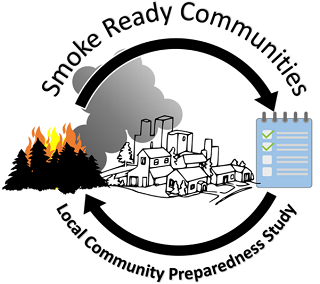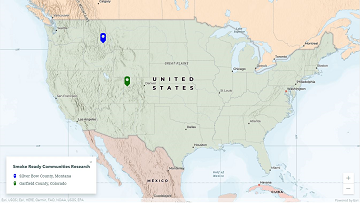Smoke-Ready Communities Research to Prepare for Wildfires

When smoky conditions from wildfires last for days, weeks or months, communities have begun to seek advice on how to develop formal plans to reduce the public health threat. Reducing exposure is important for everyone’s health — especially those more vulnerable, such as children, older adults, and people with heart or lung disease. Other communities may be impacted by seasonal prescribed burning for land management purposes, which can also cause smoke-related health concerns.
EPA researchers have identified a need to study the characteristics, elements, networks, relationships, and processes that contribute to an effective smoke-ready plan to protect public health. The study team is using a collaborative approach with partners to study the process of collaboration as well as influencing factors and early outcomes that may be related to this approach.
The research findings can be used by public health professionals, emergency response organizations, air quality managers and others to assist communities with developing a smoke-ready plan for smoke events.
Smoke-ready communities benefit public health by coordinating community-level action around indoor and outdoor air quality. They have evidence-based strategies in place to guide responses to wildfire smoke events. A range of preparedness activities may be appropriate and varies depending on the community's characteristics.
In addition, EPA and other federal agencies have developed resources to assist communities with becoming smoke ready. This includes the Wildfire Smoke: A Guide for Public Health Officials, which recommends that communities at risk for smoke events assess their vulnerabilities in advance, plan for appropriate responses, take action during a fire, and incorporate lessons learned from past smoke events into future response efforts.
Research Project
EPA is conducting the Smoke-Ready Communities Research Project with county level public and environmental health department partners to support the development of effective plans for preparing for wildfires and prescribed burning. The objectives are:
- Support county partners in their efforts to increase public health readiness for wildland fire smoke events through a collaborative approach to creating a local smoke response plan
- Contribute to empirical evidence that can inform broader guidance for local leaders on developing effective and comprehensive smoke response communication plans
- Provide insights on how existing tools and resources that aim to support local readiness are used by local smoke teams
- Contribute to the knowledge base related to fire science, collaborative governance, community capacity, and community resilience
A smoke-ready community is prepared and empowered to provide its residents with evidence-based, locally relevant information during fire-related smoke events and recommend actions to reduce public health impacts from smoke. A range of preparedness activities may be appropriate, depending on the forecasted risk for wildfires, the frequency and severity of smoke impacts, the nature of the fire event (wildfire, prescribed fire, residential wood burning), underlying vulnerabilities of local populations, and other attributes of the community.
The Smoke-Ready Communities Research Project is a multidisciplinary and interagency collaboration led by EPA and the U.S. Forest Service. The project is built around a series of interactive workshops and is designed to increase local readiness and improved public health response to wildfire smoke events. Local teams learn about the issue and work collaboratively to create a public health smoke response plan for their community.
As part of this project, EPA has engaged with leaders in each of the following counties:
The research aims to answer the following questions:
- How does a collaborative approach to planning for future wildfire smoke events influence community public health readiness for smoke?
- What are the relationships between community capacity, collaborative approaches to public health planning, and readiness for wildfire smoke events?
Research Approach and Impacts
The research design for this pilot study integrates the principles of citizen science and community-based participatory research (CBPR). This type of research brings together researchers and communities to collaborate on the study objectives with active engagement and participation by community leaders and organizations throughout the process. Researchers will provide a scientific approach to develop local wildland fire response plans with each county partner following recommendations in the Wildfire Smoke: A Guide for Public Health Officials. The approach to each partnership will be customized based on the county’s identified interests, needs and capacity to engage.
Specifically, the partnership includes efforts to:
- Support county leaders in establishing a local smoke team
- Foster relationships among team members as well as among the team and other local stakeholders through a series of monthly meetings and related interim activities
- Increase issue awareness and engagement through a series of educational workshops that cover a range of topics related to local public health readiness and resilience for wildland smoke
- Create a wildland fire public health response plan that is county-specific
- Collect research data on the local response planning process
- Potentially collaborate on future community-engaged research.
The research project is underway and will be conducted through Fall 2022. Results will be shared with community partners and published in the scientific literature. The case studies of how each county approached the more formal process of developing smoke-ready plans for their communities can provide examples for what format other counties, cities, and towns could adopt to prepare for smoke events.
Meet the Community Partners

Each partner community is unique. EPA’s community partners are putting smoke readiness to practice to help lessen the burden of wildfire smoke for others in their community. Their participation will help to provide examples for other communities interested in developing smoke-ready plans.
Garfield County, Colorado
Garfield County, located in west central Colorado, is experiencing more frequent wildfire and smoke events. The varied terrain of the county lends itself to increased and prolonged impacts of smoke events. Due to the White River National Forest’s location in the county and environment of surrounding states, the risk for wildfire and smoke intrusion is high.
The Garfield County Public Health Department saw a partnership with EPA in the Smoke-Ready Communities Research Project as an opportunity to learn how to best prepare and educate county residents on wildfire smoke events and the dangers that exposure to smoke can present.
The county’s goal is to develop stronger relationships throughout their community so there is improved communication and trust as they aim to inform residents, especially vulnerable populations, on ways to protect themselves from smoke exposure. The Garfield County Public Health Department brought together a multidisciplinary team with representatives from the local public health, government, land and resource management, Spanish interpretation and translation, fire rescue, and communications sectors.
Throughout this project, the Garfield County team has come to understand that different populations within their community receive information in different ways. Their local smoke response plan will document approaches being adopted to increase the reach of their public health risk communication. Garfield County began their engagement in this project in February 2021 and intends to have the plan available in early Summer of 2022.
City of Butte and Silver Bow County, Montana
The County of Butte-Silver Bow in Montana has seen an extreme increase in wildfire smoke conditions over the last several years, leading to unhealthy air quality conditions in the county. The county and state have faced tree mortality associated with beetle infestations, which provides fuel for wildfires, and experience wildfire smoke intrusions that have traveled from other states and settled in the area, sometimes lasting many days at a time. These threats pose risks to the community of Butte-Silver Bow for future wildfire and wildfire smoke events.
The Butte-Silver Bow Health Department decided to participate in EPA’s Smoke-Ready Communities research project in order to take actions to protect their community, especially vulnerable populations, from exposure to the harmful effects of smoke from fires.
Their goal is to create a smoke response plan that can give those living in the county guidelines and educational resources for use in protecting residents from smoke during wildfire events. EPA research project scientists and Butte-Silver Bow Health Department staff led the initiative and formed a multidisciplinary team to determine strategies needed to implement a smoke ready plan.
The team includes members from EPA, the health department, air quality experts, and community members who represent vulnerable populations. The team has developed strategies to effectively respond to smoke events from fires and has incorporated them into a smoke ready plan. The goal is to present the plan to county officials for consideration and implementation in the 2022 wildfire season.
Related Resources:
- Partners Collaborate in Smoke-Ready Communities Research to Enhance Local Readiness for Wildfires (Science Matters Newsletter Article; Aug. 16,2022)
- Smoke Ready Communities Research Study (Webinar; June 21, 2022)
- Efforts to Build an Interagency Smoke Ready Communities Program
- Wildfire Smoke: A Guide for Public Health Officials (Revised 2019)
- Smoke-Ready Toolbox for Wildfires
- Wildland Fire Research
- Fire and Smoke Map on Airnow.gov
